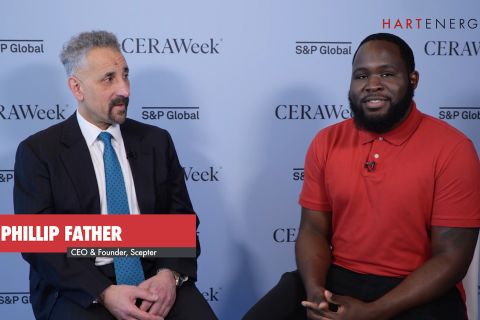Another year closer to society-imposed carbon reduction targets means it is crunch time for oil and gas operators. To reach the 2030 and 2050 benchmarks set by the energy industry, operators need to understand that, “2020 [and] 2021 have been the years of commitments; 2022-plus will be about actions,” according to Rebecca Fitz, senior director of Center for Energy Impact with BCG.
Top analytic companies have been monitoring what has and hasn’t worked so far in the industry’s energy transition. Among the list of improvements, they recommended making efforts to turn promises into actions and taking care not to neglect the governance aspect of ESG.
For this exclusive analyst roundtable, Fitz was joined by Nick Volkmer, vice president of ESG with Enverus; Olga Savenkova, senior analyst with Rystad Energy; and Steve Estes, advisory partner with KPMG, to discuss the effectiveness of the energy industry’s ESG strategies.
Hart Energy: How have operators’ ESG efforts evolved over the last year?
Fitz: To meet new commitments, strategies had to be reset, revised and finetuned, and what we saw was a lot of oil and gas companies coming forward with new strategies designed to explicitly reposition them to meet some of their new emissions goals. I would just, in general, say the big integrated supermajors, their commitments vary, but they have been on the leading edge, in some senses, of putting forward new climate commitments. But what really surprised me were the U.S. E&Ps also moved forward with new emissions commitments. And I think there’s a lot of progress to be made still, but we’re having a different dialogue than we were two years ago when it comes to these kinds of commitments.
“There’s a want in the world to decarbonize, but at the same time, the world’s not going to settle for energy scarcity anytime soon, so I think that getting those two different challenges aligned is going to be important and will be a focus from the regulatory side.” —Nick Volkmer, Enverus
Savenkova: The environmental side of ESG is under increasing spotlight for operators these days. Last year marked a turning point for the oil and gas industry as many upstream players reshaped their strategic priorities to respond to climate risk and increasing pressure from governments, regulatory authorities, investors and the public to play their part in decarbonizing the global economy. The companies’ chosen path through the energy transition will, to a large extent, determine how they allocate their capital in the years ahead.
We can underline the following key trends that evolved last year: strategic shifts with sustainability at the core; redirecting budgets and setting low-carbon investment targets; carbon pricing resilience (a stress test for investments); and low-carbon solutions in field development.
Hart Energy: What kinds of ESG strategies have proved to be most effective thus far in lowering emissions and will help operators reach their net-zero emissions goals? Which ones have been the least effective?
Volkmer: ESG is still pretty broad, and I think the exact definition of ESG is still being worked out. I think one thing that is pretty universally agreed upon though is that the ‘E’ is going to be important, especially visible components of the ‘E.’ So where we’ve seen a lot of companies focus recently is around what’s a little bit more visible, particularly flaring; we’ve seen flaring rates drop about 61% in the U.S. since 2019. Obviously that fell during COVID, but it hasn’t bounced back yet, which we believe is a sign the industry is taking ESG more seriously.
I think that the technology around methane leak detection is going to improve rapidly over the next few years, either from different field level systems or from upcoming satellites that are going to be launched and bring a lot more visibility into methane. So we’ve seen a lot of companies put dollars into either tracking methane [or] fixing known sources of methane, so pneumatic controller and devices are a really big piece there. And then we’re also seeing a lot more movement of third-party certifications on things like responsibly sourced gas.
Savenkova: We outlined three main pillars of energy transition: energy diversification, portfolio resilience and decarbonization. Using this framework, we looked at how companies are adjusting their strategies to align with the Paris Agreement’s goal to limit the increased average global temperature to 1.5 C above pre-industrial levels.
“There’s a lot of progress to be made still, but we’re having a different dialogue than we were two years ago when it comes to these kinds of commitments.” —Rebecca Fitz, BCG
The strategic priorities brought on by the energy transition differ between industry segments and regions. Direct emissions reduction together with a cost-efficient offsetting strategy seem to be essential despite company-specific priorities.
Hart Energy: How does the governance aspect of ESG play a role in boosting ESG scores?
Volkmer: When you look at oil and gas, it’s a global industry, and I think in certain jurisdictions, good governance from a safety, community and corruption perspective are important. In North America, companies tend to operate in an environment where a lot of these challenges have been overcome. What I think we’ve seen more so in North America is a push for more oversight with respect to management compensation and incentives. We’ve seen payment structures shift, [and] a lot more producers tie bonuses to specific ESG criteria, whether that’s emissions or promoting company diversity, things like that. It’s a lot more explicit now than it used to be. There’s also better alignment with shareholders. As a whole, better management incentives are one of the biggest changes we’ve seen over the past few years with respect to the governance in the energy industry in North America.
From a regulatory standpoint, [there will be] policies that directly impact things like methane emissions. We saw the EPA put out a proposal toward the end of the year with a wider mandate to regulate methane emissions. We believe these types of proposals will continue, and carbon accounting and carbon management will keep increasing in importance. I think that’s where we’re seeing a lot of the movement in the market. There’s a want in the world to decarbonize, but at the same time, the world’s not going to settle for energy scarcity anytime soon, so I think that getting those two different challenges aligned is going to be important and will be a focus from the regulatory side.
Fitz: There’s a couple of near-term issues that maybe next year or two or three I would expect to see. Most of them are emissions-centric, but I would expect to see this wave of companies announcing emissions targets and gradually more comprehensive targets, so moving on from Scope 1 targets, Scope 1 and 2 to net-zero to Scope 3.
“It’s fair that all companies will be responding to ESG and how it impacts their company, and they should absolutely be using that to set their individual goals and not just follow up [on a] copycat strategy of everybody else picking 2030.” —Steve Estes, KPMG
I would expect that to continue. I would expect more American companies to have Scope 3 targets; that’s slow work, but I think there’s pressure for that. I would expect more efforts at standardization. There is an SEC effort to force standardization in how emissions are reported overall, just to get to a place where we can benchmark targets. We can do it now, but it’s haphazard. So I think more consistency across companies and targets is going to be showing up.
Hart Energy: What is the No. 1 thing operators can do to improve their ESG scores and satisfy investors? What potential strategies or practices are being overlooked?
Fitz: Simplistically, I’d focus on emissions, just aiming for absolute transparency and benchmark-ability on your emissions. It’s not easy, but I started out benchmarking operational performance, and there’s a framework where you can do that [for] any company against any company. I think we should be aiming for that on the emissions front. And then you ultimately have top-tier, second-tier, third-tier, fourthtier quartile performers, and I think that would help, that’s a necessary step that we need to get to. We’re definitely a ways from that, but bringing transparency to that, calling out the best performers, calling out the worst performers—and no one likes to be the worst performer—I think that would be a good step. And there’s a lot of initiatives working on that, but there’s a huge number of companies that you need to bring to the table.
“The strategic priorities brought on by the energy transition differ between industry segments and regions. Direct emissions reduction together with a costefficient offsetting strategy seem to be essential despite company-specific priorities.” —Olga Savenkova, Rystad Energy
Estes: A lot of CFOs or people would say they don’t like this answer, but from a backoffice perspective, it’s creating the organizational support for creating an individual whose role is sustainability and the ESG program. In many cases, you know, there’s a number of organizations out there that are rating agencies [and] organizations that are giving a score to that entity based on different criteria. That can have an impact on future financing through green bonds or reputational risk. And you need a group that’s able to spend some time to understand, ‘Well, what are those rating agencies and groups that do have an impact on our company or our finance role?’ Understand how they’re scoring your company and have a conversation with those entities, because many times they just simply read the CSR [corporate social responsibility].
Hart Energy: 2030 and 2050 are common targets among operators and countries to achieve net-zero emissions. Between now and 2050, how do you see ESG efforts evolving throughout the energy sector as a whole?
Volkmer: Figuring out the proper primary energy mix; obviously renewables are going to increase in their share of total energy, but at what expense? I think we can agree that coal is probably going to be reduced, but natural gas is likely going to play a big component in the future, so how do those different pieces relate together? Then also, from an offsetting perspective, it kind of goes back to that measurement, like if you can’t effectively or properly calculate how much carbon is being taken out of the air from different projects, it’s hard to have a widespread carbon offsetting market. But I think that’s going to be a pretty big component to it too. Saltwater disposal, you put a ton of volumes down there, so I think just trying to sort the risks and impacts to the water question; I don’t think it’s talked about enough.
Estes: It could be all over the map. You see the majors, and some of those are taking some pretty aggressive claims and what they would like to see their company do by some of those decade milestones that are coming up. Some independents might not go that far. They’ll have goals of where they want to reduce emissions, but I think it’ll be an individual company decision based on the DNA of that organization.
I think it’s fair that all companies will be responding to ESG and how it impacts their company, and they should absolutely be using that to set their individual goals and not just follow up [on a] copycat strategy of everybody else picking 2030. We also say don’t put out a milestone date like that, that you really haven’t thought through. How likely is that, particularly your public company? You still have profitability goals that you’re out there to seek, so you still need to make sure, ‘Can I meet sustainability goals in a way that meets my shareholder expectations on performance?’ So I would say it’s going to be all aboard. I wouldn’t rush into it, but rather ease into the ESG journey.
Recommended Reading
MethaneSAT: EDF’s Eye in the Sky Targets E&P Emissions
2024-03-07 - The Environmental Defense Fund and Harvard University recently launched MethaneSAT, a satellite tracking methane emissions. The project’s primary target: oil and gas operators.
Exclusive: Scepter CEO: Methane Emissions Detection Saves on Cost
2024-04-08 - Methane emissions detection saves on cost and "can pay for itself," Scepter CEO Phillip Father says in this Hart Energy exclusive interview.


